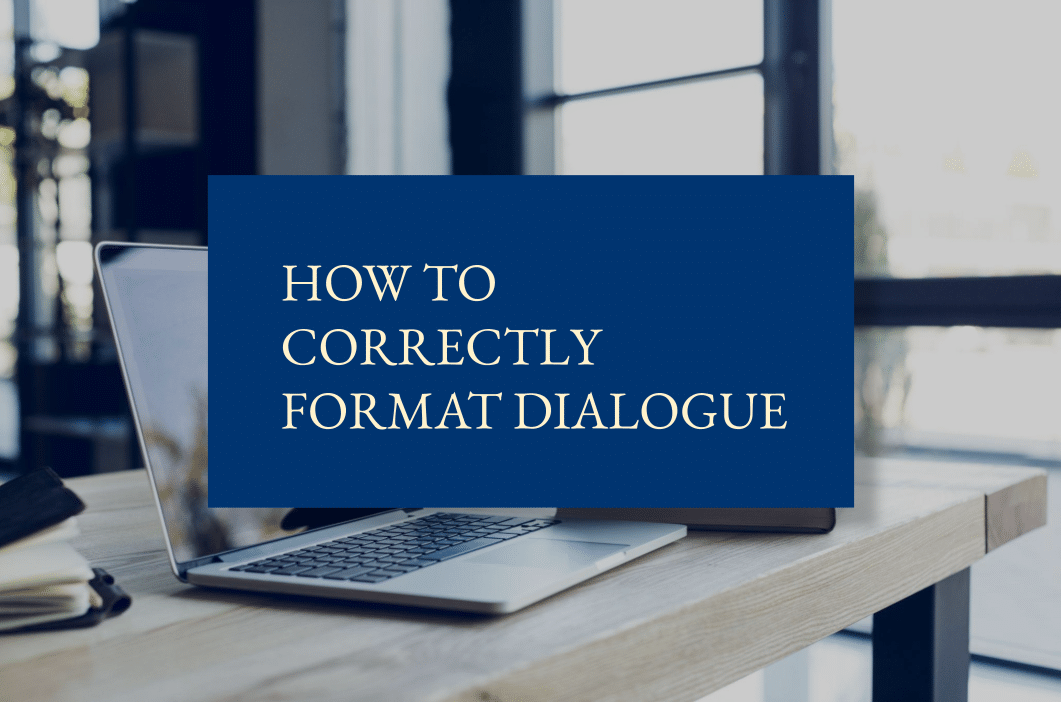
Authentic, compelling dialogue that conveys character while also moving the plot forward is one of the fiction writer’s greatest tools. But sometimes new writers get stuck on how to correctly format their character’s dialogue on the page. Even if your dialogue is on point, a formatting snafu can pull the reader (or agent, or editor) out of the story. Knowing how to avoid this will take your creative journey to the next level.
We’ll guide you through everything you need to know about formatting your characters’ dialogue so that it looks as polished and professional as a published book.
Dialogue tags vs action tags
The first thing we need to understand when formatting our dialogue is the difference between dialogue tags, sometimes called speech tags, and action tags. They’re structured slightly differently. In your writing, aim to use a balance of both.
A dialogue tag is a verb which describes the way a character is talking. “Said” is the neutral gold standard, but other dialogue tags include shouted, whispered, mumbled, murmured, asked, explained, reminded, demanded, snapped, blurted, retorted, stammered, whined, and begged. A dialogue tag specifically refers to the words that are being said.
An action tag refers to something the character is doing while they’re talking. But unlike a dialogue tag, it’s not directly tied to how the words are being conveyed. Action tags include things like nodded, shrugged, smiled, scowled, gestured, grinned, or more specific actions like raised an eyebrow, stormed away, ran a hand through their hair, and so forth.
You can also combine them by adding an action to the end of a dialogue tag: ‘She mumbled, scowling’. ‘He said with a shrug’. In these instances, you’d format this as a dialogue tag.
How to format a dialogue tag
A dialogue tag uses quotation marks to surround the speech that’s being said (double quotation marks in North American English, and single quotation marks in UK English). Inside the closing quotation mark there will be a comma. After the quoted speech, you’ll add the dialogue tag in lowercase letters.
It looks like this:
‘I’m bored,’ she said.
‘Then make yourself useful,’ he retorted.
If your character’s speech is a question or exclamation, you’ll use a question mark or exclamation mark instead of a comma. But, the rest of the formatting remains the same.
‘I’m bored!’ she shouted.
‘Then why not make yourself useful?’ he retorted.
It looks a little weird if you’re not used to it. Dialogue tags always begin with lowercase letters, because they’re an extension of the first half of the sentence (if you want to get technical, you could call this a subordinate clause).
How to format an action tag
An action tag is a bit different. Instead of composing one complete sentence out of two parts, you’re putting two complete sentences back to back. In this instance, you’ll put the dialogue in quotation marks just like before but close it with an end stop instead of a comma. Then, you’ll follow with the action tag starting with a capital letter.
It looks like this:
‘I’m bored.’ She crossed her arms over her chest.
‘Then make yourself useful.’ He turned back to his work.
Sometimes, it’s useful to put the action tag before the dialogue instead of after.
She scowled. ‘I’m bored.’
He gestured to the room. ‘Then make yourself useful.’
This structure freshens up the scene a little bit. If you’re using a question mark or exclamation mark, just switch out the end stop; everything else stays the same. Remember that UK English uses the single quote marks while North American English uses doubles.
Join our email list for authors
Join our email list for content and opportunities to help you develop your writing, promote your books, and build your author business.
How to format multi-paragraph dialogue
Sometimes you might have a character that goes on for a while because they’re either giving a speech or telling a story. In these instances, you might want to break up the text into several paragraphs.
If this happens, there are two things you can do. To format several paragraphs of unbroken speech, you’ll use opening quotation marks at the start of every paragraph and only use a closing quotation mark at the very end. This means the first few paragraphs won’t have any quotation marks at the end of them. This signals to the reader that the character is still talking.
The other way you can do it is insert some actions from other characters between the paragraphs. For example, you may have the first paragraph of a speech in between an opening and closing quotation mark, like you normally would. On the next line, you add a short action from another character like ‘The boy shifted uneasily in his seat.’ Then, you’ll use the third paragraph to go back to the speech using opening and closing quotation marks.
How to format internal dialogue
Internal dialogue usually refers to a single character’s inner thoughts, but it can also be used for dialogue between characters that aren’t speaking out loud – for example, through telepathy or sign language.
For internal dialogue, the way you format the dialogue and action tags stays the same. The only difference is that you don’t use any quotation marks, and you can instead put the quoted text in italics. It looks like this:
I’m so bored, she thought.
I wish she’d make herself useful, he grumbled to himself.
In this context, ‘thought’ replaces ‘said’.
If the dialogue is between two characters who aren’t using spoken language, the italics show the reader how to imagine the scene. They’ll now understand that these characters aren’t talking to each other in the traditional way, and that the dialogue is silent.
How to format nested dialogue
‘Nested’ means dialogue within dialogue, usually character quoting someone else. For this, you’ll need two different kinds of quotation marks. The quotation marks outside the character’s dialogue will be the ones you normally use. The ‘nested’ speech will use either double or single quotes – the opposite of your standard format.
In UK English, it will look like this:
‘As the wise bard once said, “to thine self be true.” It’s worth reminding ourselves once in a while.’
In North American English, you’ll do the opposite:
“As the wise bard once said, ‘to thine self be true.’ It’s worth reminding ourselves once in a while.”
This isn’t too common, but it’s good to be aware of so it doesn’t trip you up when you do end up using it.
Now, you’ll be able to present a manuscript that’s properly formatted so that the reader can focus on what really matters: the story.
Fija Callaghan is an author, poet, and unapologetic daydreamer. Her work has been shortlisted and longlisted for a number of short story prizes, and you can find her writing in publications like Gingerbread House, Crow & Cross Keys, Corvid Queen, and Mythic Magazine. When not writing or helping other writers get the best out of their work, she can be found haunting her local bookshops or watching the tide come in.
Join our email list for authors
Join our email list for content and opportunities to help you develop your writing, promote your books, and build your author business.
